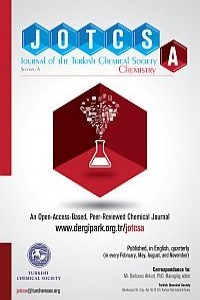Decolorization of Reactive Yellow 17 in aqueous solution by ozonation in a semi-batch bubble column reactor
In this study, the factors influencing the rate of chemical oxygen demand (COD) of a synthetic waste solutions containing water soluble reactive dye [Reactive Yellow 17 (RY17)] by ozone gas was investigated. The research was conducted using a semi-batch bubble column to take the advantage of the intensive back-mixing that prevails in bubble columns. As a result, the COD of disperse dyestuff wastewater was reduced to 78.58%, and decolorization was remarkable under the basic condition of pH 12, complete each dye degradation occurs in 12 min, ozone consumption goes on for a further 30 min after which time most degradation reaction is completed. Kinetic studies were exhibited that direct ozonation of the aqueous dyes were a pseudo-first-order reaction with respect to the dyes. The apparent rate constant increased with both applied ozone dose and higher pH values, declined logarithmically with the initial dye concentration.
Keywords:
Ozonation, Reactive Yellow 17, Reactive Dye, Decolorization COD,
___
- 1. Manu B, Chaudhari S. Anaerobic decolourisation of simulated textile wastewater containing azo dyes. Bioresource Technology 2002 82(3) 225-231.
- 2. Lourenço ND, Novais JM, Pinheiro HM. Analysis of secondary metabolite fate during anaerobic‐aerobic azo dye biodegradation in a sequential batch reactor. Environmental Technology 2003 24(6) 679-686.
- 3. Dos Santos AB, Cervantes FJ, van Lier JB. Review paper on current technologies for decolourisation of textile wastewaters perspectives for anaerobic biotechnology. Bioresource Technology 2007 98 2369-2385.
- 4. Moosvi S, Kher X, Madamwar D. Isolation, characterization and decolourization of textile dyes by a mixed bacterial consortium. Water Science and Technology 2006 36:65-72.
- 5. Gohl EPG, Vilensky LD. Textile Science Explanation: An Explanation of Fibre Properties (Second Edition) Published by CBS Publishers & Distributors Pvt. Ltd., 2005.
- 6. Corriea VM. Characterization of textile wastewater - a review. Evironmental and Technology 1994 15:917-929.
- 7. Slokar YM, Marechal AM. Methods of discoloration of textile waste waters. Dyes and Pigments 1998 37:335-356. 8. Gutierrez MC, Crespi M. A review of electrochemical treatments for colour elimination. Journal of the Society of Dyers and Colourists 1999 115:342-345.
- 9. Lorimer JP, Mason TJ, Plattes M, Phull SS, Walton DJ. Degradation of dye effluent. Pure and Applied Chemistry 2001 73:1957-1968.
- 10. Gupta VK, Khamparia S, Tyagi I, Jaspal D, Malviya A. Decolorization of mixture of dyes: A critical review. Global Journal of Environmental Science and Management 2015 1(1):71-94.
- 11. Georgiou D, Melidis P, Aivasidis A, Gimouhopoulos K. Degradation of azo reactive dyes by UV radiation in the presence of hydrogen peroxide. Dyes and Pigments 2002 52(2):69-78.
- 12. Soares PA, Silva TF, Manenti DR, Souza SM, Boaventura RA, Vilar VJ. Insights into real cotton-textile dyeing wastewater treatment using solar advanced oxidation processes. Environmental Science and Pollution Research International 2014 21(2):932-945.
- 13. Asghar A, Raman AAA, Daud WMAW. Advanced oxidation processes for in-situ production of hydrogen peroxide/hydroxyl radical for textile wastewater treatment: a review. Journal of Cleaner Production 2015 87:826-838.
- 14. Cardoso JC, Bessegato GG, Zanoni MVB. Efficiency comparison of ozonation, photolysis, photocatalysis and photoelectrocatalysis methods in real textile wastewater decolorization. Water Research 2016 98:39-46.
- 15. Gottschalk C, Libra JA, Saupe A. Ozonation of Water and Waste Water: A Practical Guide to Understanding Ozone and its Applications, 2nd Edition, WILEY-VCH., 2009.
- 16. Von Gunten U. Ozonation of drinking water: Part I. Oxidation kinetics and product formation. Water Research 2003 37(7):1443-1467.
- 17. Von Gunten U. Ozonation of drinking water: Part II. Disinfection and by-product formation in presence of bromide, iodide or chlorine. Water Research 2003 37(7):1469-1487.
- 18. Turhan K, Turgut Z. Reducing chemical oxygen demand and decolorization of direct dye from synthetic wastewater by ozonization in a batch bubble column reactor. Fresenius Environmental Bulletin 2007 16(7):821–825.
- 19. Turhan K, Turgut Z. Decolorization of direct dye in textile wastewater by ozonization in a semi-batch bubble column reactor. Desalination 2009 242(1-3):256-263.
- 20. Turhan K, Ozturkcan SA. Decolorization and degradation of reactive dye in aqueous solution by ozonization semi-batch bubble column reactor. Water, Air and Soil Pollution 2013 224:1353-1358.
- 21. Turhan K, Turgut Z. Treatment and degradability of direct dyes in textile wastewater by ozonation: A laboratory investigation. Desalination and Water Treatment 2009 11(1-3):184-191.
- 22. Turhan K, Uzman S. Removal of phenol from water using ozone. Desalination 2008 229(1-3):257-263.
- 23. Turhan K, Durukan I, Ozturkcan SA, Turgut Z. Decolorization of textile basic dye in aqueous solution by ozone. Dyes and Pigments 2012 92(3):897-901.
- 24. Wang C, Yediler A, Lienert D, Wang Z, Kettrup A. Ozonation of an azo dye C.I. Remazol Black 5 and toxicological assessment of oxidation products. Chemosphere 2003 52:1225-1232.
- 25. Wu J, Eiteman MA, Law SE. Evaluation of membrane filtration and ozonation processes for treatment of reactive-dye wastewater. Journal of Environmental Engineering 1998 124(3):272-277.
- 26. American Public Health Association (APHA), American Water Works Association (AWWA), and Water Environment Federation (WEF), Standard methods for the examination of water and wastewater, American Public Health Association Publ., 21th ed., Washington DC, 2005.
- 27. Langlais B, Reckhow DA, Brink DR, Ozone in water treatment: application and engineering, Boca Raton: Lewis Publishers, 1991:31-54.
- 28. Raghuvanshi SP, Singh R, Kaushik CP, Raghav AK. Removal of textile basic dye from aqueous solutions using sawdust as bio-adsorbent. International Journal of Environmental Studies 2005 62(3):329–339.
- Başlangıç: 2014
- Yayıncı: Türkiye Kimya Derneği
Sayıdaki Diğer Makaleler
Zerrin ZERENLER ÇALIŞKAN, Nezhun GÖREN
Onur ALPTURK, Z. Sevcan YEŞİLBAŞ, Gözde SARIOĞLU, Aslı KARAÇAYLI, Aytül SAYLAM, Salih ÖZÇUBUKCU
Ertuğrul Gazi SAĞLAM, Nurcan ACAR
Nilay Akkuş Taş, Ayşegül Şenocak, Ali Aydın
Md. Boshir AHMED, Ajoy KUMER, Muhammad ISLAM, Tajmeri Selima Akhter ISLAM
